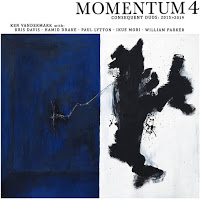By Keith Prosk and Paul Acquaro
Momentum 4 is a box set of duo recordings by Ken Vandermark, recorded at the Elastic Sound Studios in Chicago in 2015 and 2019, and at NYC’s Stone in January 2018. The idea was to capture rare duo performances – even if the musical relationships have been ago long established.
In our review, we have deviated from the order of the discs and begin with Keith’s assessment of discs 2 and 3 where Vandermark is in duet with electronics player Ikue Mori and pianist Kris Davis. Then, we’ll come back to my thoughts on his duets with drummers Paul Lytton and Hamid Drake, and finally bassist William Parker.
What makes Vandermark so special is not just the distinctive character of
his musicianship but his character itself, and the feedback loop between
them. His writing articulates an openness to listen and to learn; his
playing demonstrates it by giving others generous space and apt
communication. The subversion of personal patterns is a constant motif.
This creative giant, who should by now be comfortable and confident in
every move, is in such a position exactly because he’s purposefully not.
For this reason I gravitated towards these discs, which feature musicians
that don’t have a decades-long rapport with Vandermark like Lytton, Parker,
and Drake. Freely-played duos with less-than-familiar musicians seems like
excellent laboratory conditions for witnessing the instant development of
Vandermark.
Disc 2: Ikue Mori
Ikue Mori first played with Vandermark during his first Stone residency in
2016, documented on Momentum 1: Stone, with Nate Wooley and Joe
Morris. It was a strong set among many strong sets, just like this one,
which was recorded at Vandermark’s second Stone residency in 2018 (along
with the Davis and Parker discs). For 46 minutes, split across two tracks,
Mori is on laptop and Vandermark is on saxophone. Mori’s software and
technique can generate a chimerical barrage of percussion, displaying many
faces of beat and rhythm simultaneously, like a digital drumming
hecatoncheires; pulses created by droning pitches’ oscillating frequencies,
electric purrs and percussive flutters, glitched clicks and cavernous water
drops, and more recognizable drum machine sounds can occur closely
together. But the timbres are often soft and the volume is often low, so it
feels non-aggressive. And though this seemingly living percussive
environment sometimes flirts with becoming ambient, Mori avoids this with
judicious strokes of sound surrounded by plenty of space. Perhaps because
of its tirelessness, or perhaps because of its innumerable lines in
contrast to the mostly monophonic sax, the software environment can feel
like a wall which Vandermark throws himself against, starting the set with
energetic bursts of varying technique as if to test it.. It’s difficult to
tell whether my ear adapts or Vandermark does or both but, as the set
continues, Vandermark’s own high pitch frequency oscillations, snaking
sinusoidal multiphonic lines, and glitchy click and tongue slap pulses sync
well with Mori, phasing in and out of counterpoint. It’s perhaps the most
rhythmic set I’ve heard from this rhythmic saxophonist. Some other
Vandermark characteristics, like his deep vibrato and moody, smoky, soulful
melodies, are here, and there’s a couple stunning moments where Mori’s
environment focuses into a booming four on the floor beat over which
Vandermark rips loose a freeform freakout. Vandermark’s instrument allows
greater agility in communication, but Mori’s software is surprisingly
mobile itself, allowing a conversation as lively as the other acoustic sets
here. My favorite thing Vandermark has released all year, and it’s been
quite a year for him.
Disc 3: Kris Davis
Kris Davis first played with Vandermark in 2016 during the sessions for Sing Me Some Cry, with Eric Revis and Chad Taylor. They reunite
here for their second recording, for 3 tracks across 53 minutes, with Davis
on piano and Vandermark on all sax again. The chemistry of this set belies
their time spent together. They are rapidly responsive to each other.
Davis’ muted rhythms and hammered keys, beautiful boppy chords and
melodies, free flights, thunderous reverberations, and clock strikes and
twinkling glissandos inside the piano are matched well with Vandermark’s
rhythmic clicks, sultry soul tunes, energetic free frenzies, and resonant
vibrato. They follow each other’s ebbs and flows through volume, space, and
time and also up and down their instruments registers like friends who
finish each others sentences. It’s not just a communicative match, but
Davis also seems to share Vandermark’s rhythmic essence and a similar
inside-outside aesthetic. The set seems so natural, you’ll wonder why they
didn’t start playing together sooner.
– Keith Prosk
Disc 1: Paul Lytton; Disc 5: Hamid Drake
In the thoughtful booklet accompanying the box set, Vandermark talks about the impact that the work of the first generation of British improvisers, who broke free from the parameters of jazz and developed their own musical language, has had on him. Lytton’s history itself goes back to the late 60’s in London and he has a long history of playing with the musicians of from this movement. Vandermark recalls a particularly revelatory conversation with Lytton where he wanted to draw on what he had learned from the music, to which the drummer explained that the Saxophonist’s playing “implied a beat.”
Disc 4: William Parker
When this fourth installment of the Momentum series came out a few months ago, I quickly jumped at the chance to review it with my colleague Keith. I had thoroughly enjoyed the original set of recordings from Ken Vandermark’s week at the Stone in January 2016 (and had had the chance to attend some of the concerts) and after the intensity of volumes 2 and 3, I was ready for more. Suffice to say, this is a heavy set of music, there is a lot to digest, and a lot to savor. I’ve had been listening to it for months now, repeatedly, and I hope you have been – or will soon be – as well.


